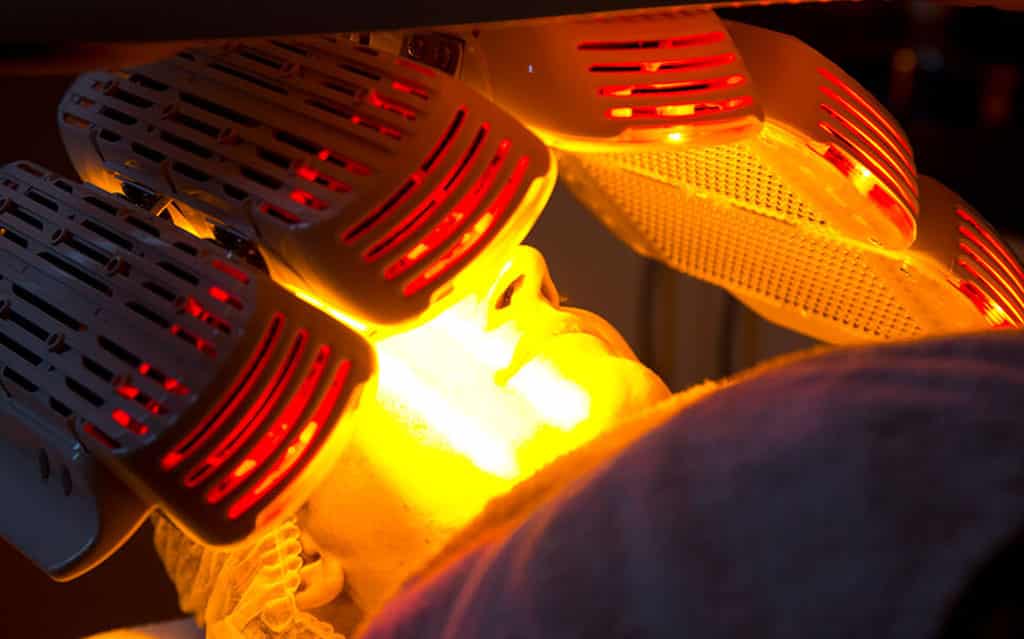As I’m sure you know, circulation in the lymphatic system is purely passive, with a small number of simple valves (e.g., ankles, knees and groin in the lower extremities) to prevent backflow. There are two recognized stimuli for circulation: one of them is movement e.g., of the feet, legs, muscles and so on, which have a mechanical pumping effect, and the other is the pulsing of the arteries round which lymph vessels twine. As the arteries pulse with the pressure of the systolic and
diastolic beats, the lymph is forced to move distally. When a painful area, or any area, is irradiated with 830 nm, in particular, there is a dilation of the local and neighbouring arterial plexi caused by local changes in cytokine synthesis through 830 nm-mediated mast cell degranulation, for example. This further helps push the lymph onwards.
Secondly, 830 nm has a relaxing effect on involuntary muscles due to its activation of the parasympathetic system which also causes vasodilation. The excellent results in post-mastectomy lymphedema with 830 nm LLLT which have been well-reported in the literature demonstrate one practical indication dependent on, and well-demonstrating, enhanced lymphatic circulation.
Another scenario is a chronic joint condition, such as arthrosis. In this situation the vessels and nerves in the affected joint have become compressed and constricted by the fibrotic formations associated with chronic arthritis: this includes the lymphatics. Fine plate thermography of an arthritic joint will show a blue to dark blue colour compared with the surrounding “warm” tissue in reds and yellows. This is indicative of the compromised circulation to the joint. LED-LLLT can loosen and soften the fibrotic capsule, decompressing nerves and allowing the blood and lymphatic vasculature to start working properly again. On thermographic assessment, the joint will now often be “warmer” than the surrounding normal tissue, indicative of restoration of blood flow. An interesting side note to this is the fact that a chronic joint is restored to an acute condition with LED-LLLT sessions, and this very often intensifies the pain in the joint, so that it gets worse before it gets better. However, 830 nm is very effective on acute pain, so that is swiftly ameliorated.
Chronic pain patients being treated with LLLT should be told to expect this, so they don’t think they are getting worse!
If the bone is stimulated using LED does it have an effect on ageing i.e. facial structures?
The interesting thing about LLLT is that it works as an internal balancing mechanism, so if there is an imbalance, LED-LLLT will help that to be addressed so that normal homeostasis is returned. Before talking about bone, let me address the specific problems of the ageing face with which LED treatment can help. In the ageing face, the imbalance is mostly in the extracellular matrix scaffolding, with the gradual deterioration of resilience in collagen and elastin fibres and ageing of the fibroblasts themselves, coupled with poor cellularity in the epidermis with a dull-looking and disordered stratum corneum.
The blood supply, too, can be compromised. LED-LLLT works on restoring normal function to the fibroblasts, and through them, re-ordering the poor structural strength of the ECM with restored rete peg formation, which increases the area of contact between the dermo-epidermal junction and the papillary dermal blood supply which nourishes the epidermis. Because epidermal basal layer mother keratinocytes are a target for 830 nm, the epidermis is also revitalized, with better cellularity and a better-organised stratum corneum. Any problems with the blood supply to the ECM are also solved, oxygenating and nourishing the components of the ECM.
The effect of 830 nm LED-LLLT on bone is also a restorative one, ensuring a better blood supply through the periosteum and into the Haversian system. Bone mineralization is improved. Osteoblasts haven shown to be “switched on” at the genetic level. There are studies showing increased bone density following 830 nm LED in osteoporotic women. Therefore the role of LEDs in strengthening the maxillofacial bony structures is one of maintenance rather than repair unless there is something to be repaired. This is an obvious aid to helping to turn back the ageing clock. Of course, it only turns it back and doesn’t stop it, so regular top-up treatments are a very good suggestion for patients with ageing facial skin after they have their 4-week, 8-session main treatment (or whatever your protocol is). LED-LLLT is also a very good complement to cosmeceutical skincare regimens.
What if you don’t want LED to penetrate bone; do you have any control over this? Are there any side effects?
The problem with trying to attenuate LED energy is that the overlying soft tissues, which are probably the target for the LLLT approach, don’t get the full benefit of the LED photon energy. In fact, I can’t imagine any case where I would not want the bone to enjoy the benefits of LED-LLLT, even in healthy bone. In healthy targets, because they are in a normal state of homeostasis, transient effects are noted such as an increased blood flow rate and volume. As this is not really required by the organism it will drop back to normal. In the meantime, however, even healthy tissues, including bone, can benefit from a bit of extra oxygenation. I would summarise that the only side effects are good ones!
Answers provided by Dr Glen Calderhead



 by
by